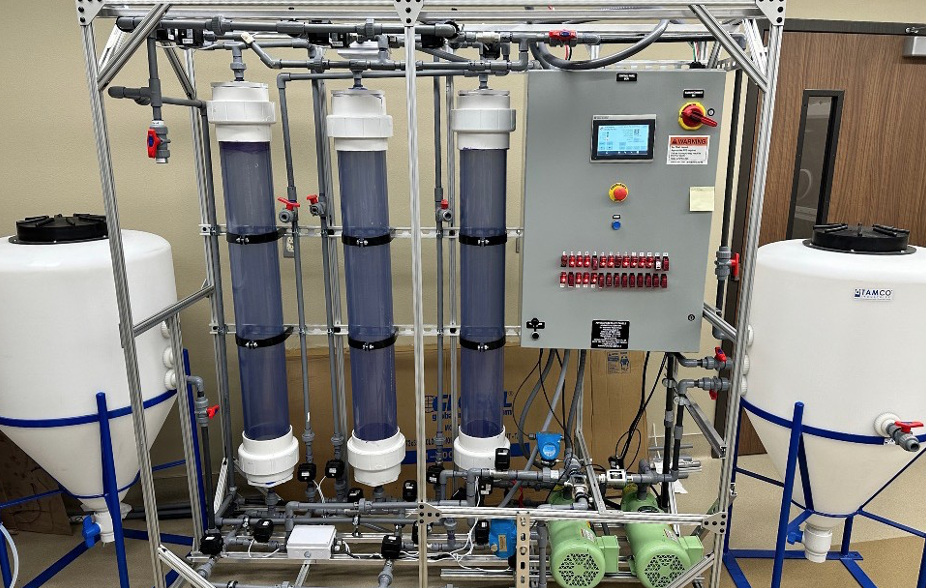CASFER Researchers Produce Fertilizer from Activated Sludge at Wastewater Treatment Plants
Outcome/Accomplishment
Researchers at the Center for Advancing Sustainable and Distributed Fertilizer Production (CASFER), a National Science Foundation (NSF) Engineering Research Center (ERC) based at Texas Tech University completed the design of a new process to produce nitrogen-based fertilizer (NBF) and probiotic food (PBF) in a testbed. As a result of the innovative technique, a new sludge electrolysis process is capable of recovering nitrogen from centrate in wastewater treatment plants (WWTP).
Impact/Benefits
The production of decarbonized NBFs is critical to enabling a more resilient and sustainable food production system. Researchers at CASFER are looking to activated sludge as a potential source. Within WWTPs, activated sludge—the result of a process for treating sewage and industrial wastewaters—has proven to be an organic-rich material with high potential to produce value-added chemicals. By leveraging catalytic technologies to recover NBFs and PBFs from wastewater, CASFER researchers can produce up to 1 kilogram per batch of a new form of fertilizer, CASFER super compost.
Explanation/Background
Lead testbed researchers Kayleigh Millerick, Christian E. Alvarez-Pugliese, and Tarek Abichou completed the construction of the WWTP pilot testbed to help validate the design and optimize the engineering variables to produce NBF and PBF. The testbed will be used by CASFER to assess efficiency, integration of components, durability, quality of NBF (such as its composition and pathogens analysis), determination of MVP (a naturally derived broad spectrum microbial blend), compliance with regulations, and safety protocols. Initial efforts focused on the design of the sludge electrolysis reactor, electrode architecture and composition, flow profile, and operating potential. The resulting process addresses technology gaps to help accelerate NBF and PBF commercialization.
Location
Lubbock, Texaswebsite
Start Year
Energy and Sustainability
Energy, Sustainability, and Infrastructure
Lead Institution
Core Partners
Fact Sheet
Outcome/Accomplishment
Researchers at the Center for Advancing Sustainable and Distributed Fertilizer Production (CASFER), a National Science Foundation (NSF) Engineering Research Center (ERC) based at Texas Tech University completed the design of a new process to produce nitrogen-based fertilizer (NBF) and probiotic food (PBF) in a testbed. As a result of the innovative technique, a new sludge electrolysis process is capable of recovering nitrogen from centrate in wastewater treatment plants (WWTP).
Location
Lubbock, Texaswebsite
Start Year
Energy and Sustainability
Energy, Sustainability, and Infrastructure
Lead Institution
Core Partners
Fact Sheet
Impact/benefits
The production of decarbonized NBFs is critical to enabling a more resilient and sustainable food production system. Researchers at CASFER are looking to activated sludge as a potential source. Within WWTPs, activated sludge—the result of a process for treating sewage and industrial wastewaters—has proven to be an organic-rich material with high potential to produce value-added chemicals. By leveraging catalytic technologies to recover NBFs and PBFs from wastewater, CASFER researchers can produce up to 1 kilogram per batch of a new form of fertilizer, CASFER super compost.
Explanation/Background
Lead testbed researchers Kayleigh Millerick, Christian E. Alvarez-Pugliese, and Tarek Abichou completed the construction of the WWTP pilot testbed to help validate the design and optimize the engineering variables to produce NBF and PBF. The testbed will be used by CASFER to assess efficiency, integration of components, durability, quality of NBF (such as its composition and pathogens analysis), determination of MVP (a naturally derived broad spectrum microbial blend), compliance with regulations, and safety protocols. Initial efforts focused on the design of the sludge electrolysis reactor, electrode architecture and composition, flow profile, and operating potential. The resulting process addresses technology gaps to help accelerate NBF and PBF commercialization.

